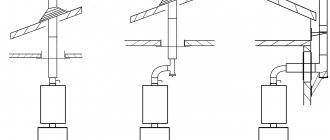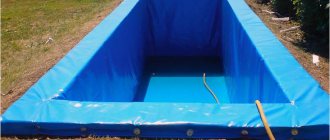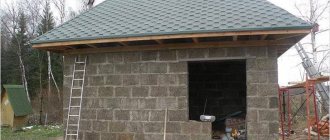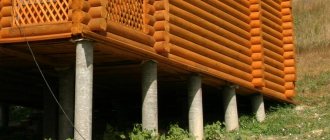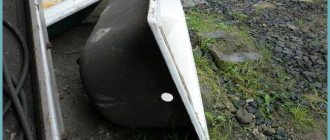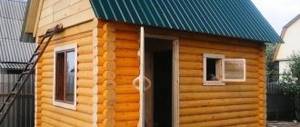For the most part, owners of country plots set up a bathhouse on their property, it doesn’t matter if it’s a permanent home or a summer house.
Traditional construction requires wastewater disposal. Of course, you can buy a ready-made system, but the designs are expensive. There is always a solution - to make a septic tank for a bathhouse with your own hands.
The first thing to decide is whether the building will be equipped with a toilet.
Drains from a bathhouse without a toilet contain epidermis, soapy water, a little grease and leaves from brooms. This allows the installation of any system without pumping. The presence of a latrine in a building changes the nature of the water; therefore, not every septic tank can cope with sewage waste.
Selection of tires for septic tanks and other materials
It is desirable that they be of large diameter and maximum width - from heavy vehicles - there are enough of them at truck tire shops. The quantity depends on the width of the tires. It is desirable that their total height be 2 - 2.5 m. For the upper part you will need 2 - 3 slopes of smaller diameter, but harder.
If you plan to make a septic tank with overflow into a second (third) well, then increase the number of tires according to the task.
You will also need about 1 cube of coarse crushed stone, half a cube of fatty clay, sand, a steel pipe with a diameter of 100 - 120 mm, and a sewer manhole assembly. It wouldn’t hurt to have scraps of a half-inch polypropylene pipe 15–20 cm long in quantities of 3 or 4 pieces. at each joint between the slopes located below the drain pipe.
If you are planning a septic tank with an overflow, then you will need a reinforced concrete paving slab with dimensions larger than the internal diameter of the top tire, which will need to close the receiving well, and a piece of geomembrane (or a material replacing it) with dimensions larger than the diameter of the top tires by approximately 100 mm.
To cut tires, you may need a powerful sharp knife, a grinder with a circle for metal 125 - 150 mm and (or) a jigsaw with a file for the same material, a screwdriver, and self-tapping screws.
Double chamber
This type of septic tank is most suitable for a bathhouse, especially if you plan to use it frequently. It can be purchased or made at home from tires, reinforced concrete well rings and concrete mortar.
Additional information: Installation of water supply in a private house - diagram
How to do:
- First of all, dig 2 holes in which the septic tank chambers will be located. Their length must be at least 2 meters. It is worth considering that in the future there will be crushed stone, sand or other drainage in the gap between the walls and the wheels.
- We place tires in piles in the pits.
- Now you need to bring the sewer line and connect it to the camera.
Principle of operation
As you already understand, to obtain better cleaning of wastewater from a bathhouse with a toilet, it is better to make not one settling tank, but several filtration compartments. In each of them, the wastewater undergoes multi-stage purification, and at the output you will receive completely harmless purified water, which can be used for technical needs and watering the garden.
As a rule, to install a septic tank under a bathhouse with a toilet, a two-chamber design is required. In this case, both chambers are connected to each other by an overflow. The operating principle of such a structure is as follows:
How to make a septic tank from concrete rings with your own hands?
- The drainage from the bathhouse enters the first compartment of the structure through a pipeline. Here, the heavier and denser components of the wastewater settle to the bottom.
- In addition, wastewater in the first chamber, where there is no oxygen, undergoes primary purification by anaerobic bacteria. These microorganisms live in conditions without access to oxygen, so such a chamber is a favorable habitat for them.
- When the level of liquid waste in the first compartment reaches the overflow location mark, the water flows by gravity into the second compartment.
- If the design of the second chamber does not provide a bottom, then the treated wastewater is filtered through a layer of gravel and crushed stone into the soil. If the septic tank under the bathhouse has a bottom in the second chamber, then the wastewater is discharged through a special pipe into a filtration well or ditch.
It is worth noting that during the life of bacteria, wastewater decomposes into gas and water. As a result of the activity of anaerobic organisms, methane gas is formed, for the removal of which a ventilation duct is needed. To populate a septic tank with special microorganisms, ready-made biological products are used.
Ready-made models
If you don’t have time to worry about how to make a septic tank for a bathhouse with your own hands, it makes sense to purchase practical and functional devices at an affordable price. Popular models:
| Model name | Characteristics | Price range |
| Septic tank “Triton” Mini – 750 l/Micro – 450 l | Double-chamber/single-chamber. Light weight – 70/40 kg. Withstands temperatures down to -30 ⁰С. Equipped with a post-treatment system. | The cost of the kit with infiltrator, lid, neck is about 21,000/12,000 rubles. |
| DKS 15 and 15M | Capacity – 450 liters per day. Autonomous, easy to maintain. | About 29,000-33,500 rubles. |
In addition, there are a large number of deep cleaning stations such as “Topas”, “Unilos”, etc., the price of which will be much higher. However, the optimal solution for a bathhouse is simple installations with mechanical filters and sedimentation tanks, which, if necessary, can be equipped with a soil purification system.
General rules for sewerage installation
Depending on the level of sauna water supply and sewage system, wastewater with different levels of toxicity flows out of it. From showers in bathhouses and washing machines, water comes out saturated with washing powder and soap suds with minor inclusions of organic matter. In order to neutralize their influence, a simple settling tank equipped with a sand filter is sufficient. A septic tank for a bathhouse with a toilet should be more thoroughly equipped.
To do this, you will need to build a septic tank consisting of several interconnected settling tanks. In this case, you should take into account the volume of wastewater leaving the bathhouse and the type of soil on the site. The type of soil refers to its ability to absorb filtered liquid. If the soil composition is dominated by clay, then the issue of draining wastewater into a specially constructed closed reservoir should be considered.
As a rule, to keep the area clean, septic tanks are made, consisting of 2-3 tanks of various capacities. Their volume is selected based on preliminary calculations of the maximum amount of wastewater with a margin of 25-30%.
The first tank is used as a coarse filter. All large fragments of wastewater are retained in it. To delay them, crushed stone of medium and fine fractions is used. Content changes as needed. Depending on the intensity of use of the bathhouse, the septic tank for a bathhouse without pumping is cleaned once every 1-3 years.
In the second tank, the contaminated liquid is settled. All suspended substances precipitate. Within a few days the water becomes almost clear. It flows into the third tank.
A thick layer of fine crushed stone and sand is poured into the drainage container. The water passes through this filter and becomes almost pure. Absorbing into the soil, it moisturizes it, but does not poison it.
Such a system can operate successfully for years without requiring complex maintenance or cleaning. Given the insignificant volume of wastewater from the bathhouse, there is no need to bury large tanks in the ground. Moreover, installing an industrial septic tank will be economically unjustified, especially for equipping bathhouses that are used only in the warm season or periodically.
Manufacturing for baths and toilets
If you need to make a septic tank for both a bathhouse and a toilet located inside it, you need to understand that black waste will flow into the container. Therefore, it is prohibited to install structures without a bottom.
You need to choose a design with two cameras. If the installation is homemade, you need to take care of sealing. To do this, you need to check all the joints and install the outer frame on top of the inner one.
To ensure that the water remaining after bathing procedures and washing goes into the soil without harming the environment, it is necessary to equip a special septic tank. Its task is to clean the used liquid from chemicals, soap, and debris. If you don’t want to spend a lot of money on a purchased device, you can assemble it yourself from available materials.
Installation of a septic tank made of reinforced concrete rings
The use of ready-made concrete rings can significantly reduce construction time if you do it yourself. The best option is to use reinforced concrete products with a height of 60 cm and a diameter in the range of 90-150 cm. The weight of the rings ranges from 400-600 kg. It is quite possible to move them around the site manually without the use of mechanization. It is better to choose rings whose edges are equipped with sides. A shaft made from such rings is characterized by increased strength and tightness. The kit includes a base plate and a top with a hatch. Products with brackets on the inside are well suited for creating deep wells.
In order to make a septic tank from reinforced concrete rings, you will need the following tools and materials:
- shovel;
- oil level;
- winch with cable and bucket;
- plumb line to check the verticality of the pit;
- lever for moving the ring;
- cement or bitumen for sealing joints.
The work of installing a sewer shaft can take from 1 day to a week. This depends on its depth, the diameter of the rings and the density of the soil.
Activities for arranging a septic tank are carried out in the following sequence:
- The terrain is being marked. The route for pipes and places for installing tanks are outlined.
- Excavation is underway. A ditch and holes for the rings are dug out. The depth of the pit must correspond to the height of the reinforced concrete products. The diameter should be 10-15 cm larger than that of the ring.
- The first ring is lowered into the pit. Its edges are treated with sealant. The second fragment of the well is rolled up and placed on them.
- Soil is being excavated from under the lower edge of the first reinforced concrete product lowered into the pit. The structure settles under its own weight.
- 5. All other rings are attached in the same way. When the latter is inserted, sand is poured between the walls of the pit and the shaft.
- If this is a tank for primary cleaning, then its bottom is sealed with reinforced concrete screed. The bottom of the drainage is covered with a layer of sand and fine gravel.
- Holes are made in the walls of the mine. Sewer pipes are inserted into them. The cracks are carefully sealed.
Hatches are installed on top of the rings. To release gases, an exhaust pipe is inserted into them, which can be raised to a height of up to 3 m, so that unpleasant odors do not disturb the inhabitants of the dacha.
Industrial septic tanks
Those who do not want to bother with arranging a septic tank on their own prefer to purchase factory-made models of such products.
The following models are considered the most popular:
- The Triton septic tank is available in two versions – micro 450 l and mini 750 l. Available in single- and double-chamber versions, with a weight of 40 and 70 kg, respectively. The design can withstand up to -30 ºС. A post-treatment system is included in the kit. The entire set, which also includes a lid with a neck, will cost consumers 12 and 21 thousand rubles, respectively.
- Septic tanks of models DKS 15 and 15M are capable of processing up to 0.45 m3 of liquid per day. They are easy to use and maintain. Such products cost about 29-35 thousand rubles.
For deeper cleaning, stations of the Topas, Unilos and similar models can be found on the market. Such filtration systems require more significant costs.
However, we note that simple designs equipped with sedimentation tanks and filters for rough cleaning are best suited for installation in a dacha. If necessary, you can supplement them with additional soil treatment.
Nuances of selection and installation
To correctly select and install a septic tank, you need to follow several rules.
Septic tank volume
It is worth making simple calculations on the amount of wastewater from the bathhouse.
Example. 6 people take a bath at a time. On average, everyone uses 50 liters of water
6*50=300l
The septic tank must have a volume of at least 400 liters. Taking into account that no one will go to the bathhouse next. If it is designed for several visits in a row, then the volume triples.
If the bathhouse is equipped with a font
When choosing the volume of a septic tank, you should take into account the drainage of the container.
- Bathhouse with or without toilet. The bathroom in the bathhouse - a two-chamber septic tank is definitely installed.
- The septic tank is installed at a distance of 3-5 meters from the bathhouse.
- The slope of pipes and sewer and connecting sections is always maintained at 2-3 cm per meter. This is necessary to create gravity flow. Otherwise, the system will become clogged or a pump will have to be installed.
- The two-section septic tank must have free access for sewage disposal equipment. Service equipment hose 6-15 meters.
- The cleaning system is always set up according to the slope of the terrain. Sump at a high point, drainage well towards the bottom.
- Sewer pipes should be insulated, which will help avoid freezing during the cold season. Or lay them below the soil freezing level.
Sanitary standards
Before you begin installing a septic tank at your summer cottage, you need to study sanitary standards, select the area, and the installation capacity. If something goes wrong, you can poison the soil with waste and harm people living in the surrounding area.
Power
The power of a septic tank is its dimensions. To calculate what size the structure should be, you need to perform several steps:
- On average, after three people, 100 liters of water drain.
- This number must be multiplied by 3. The resulting 300 liters are converted to m3. This volume is enough for 1 day.
- It must be taken into account that the water must stand for 14 days to be completely cleaned.
The optimal chamber volume for 3 people is 4 m3.
Location
The location must be chosen depending on the type of surrounding buildings and plants:
- fruit trees - 3 meters;
- fences - 3 meters;
- residential buildings - 5 meters;
- stream, pond - 10 meters;
- wells - 25 meters;
- reservoirs - 30 meters;
- wells - 50 meters;
- treatment facilities - 5 meters.
It is recommended to draw in advance a diagram of the location of the main objects on the site and think over the location of the septic tank.
Place for draining liquid
There are several options for where the waste fluid is drained:
- on uneven terrain;
- into the soil;
- into the pond.
The water must undergo long-term filtration to remove any debris or harmful substances.
Selection rules
When purchasing or making a septic tank for a bathhouse, it is necessary to take into account the nature of the wastewater that it will have to process. As a rule, the bulk of waste from this facility is “gray water”, consisting of water with soap suds, surfactants and fatty acid derivatives. They also contain small amounts of hair and skin particles.
If the bathhouse is equipped with a toilet, then the nature of the waste will be somewhat different. Sewage water of this type is usually called “black”, and their treatment and disposal is more responsible. In this case, it is necessary to construct a reliable treatment plant with several sealed settling chambers.
A septic tank for a bathhouse can be single-chamber or double-chamber. A single-chamber septic tank is the simplest treatment facility, consisting of a container without a bottom and operating on the principle of a filter well. In this case, the function of a reservoir can be performed by various devices such as metal barrels without a bottom, as well as plastic containers with holes made in them, reinforced concrete rings, old car tires, etc., and the filter is a layer of crushed stone at the bottom.
Please note that when constructing such a septic tank on your own site, you must take into account the location of groundwater in the place where it will be located. If their level is high enough, the purification chamber must have a sufficient volume so that a large amount of wastewater simultaneously generated during the use of the bathhouse can completely fit inside the tank
A septic tank for a bathhouse with a toilet should ideally be at least two-chamber. This option is also worth using when you plan to use the bathhouse quite often. You can purchase it ready-made or build it yourself using reinforced concrete well rings, concrete mortar or plastic containers (Eurocubes) and the same tires.
The first chamber in this case is used as a mechanical cleaning filter. A mixture of crushed stone and gravel of small fractions is poured into it, purifying “gray waste” from larger impurities. The second chamber serves as a settling tank in which water that passes through a mechanical filter settles. Then the water moves into the drainage well, from which it is gradually absorbed into the soil. This option is good for those who need a septic tank for a bath without pumping. A septic tank has a similar operating principle, in which the first chamber will be used for mechanical cleaning, and the second will be a drainage well with a bottom filter.
Options for collecting wastewater from a bathhouse
If you have chosen the option of making your own septic tank, you need to study the stages of the work. It is recommended to draw up a drawing of the future design in advance, prepare consumables and tools.
To correctly position the vertical drain channel, you need to draw a drawing of the entire area. It should indicate the distance to each object, building, large tree. Choose a place.
Using shovels, dig a pit for the septic tank. The greater its depth, the better. When choosing the depth, you need to take into account the height of the groundwater.
To carry out the work you should prepare:
- concrete mixer, boards, slats;
- screwdriver, hammer, nail puller;
- building level;
- fittings, two metal hatches;
- bayonet, shovel;
- buckets, bricks.
Additionally you will need cement, sand, gravel.
Formwork
Before you start mixing the cement mortar, you need to assemble the wooden formwork into which it will be poured. Execution of work:
- Put together a common formwork from wooden panels.
- Divide the wooden structure into two sections with a separate partition.
- Using thick beams, make spacers that will hold the structure during pouring and hardening of the cement mortar.
To increase the reliability of the formwork, it is recommended to secure reinforcement between the wooden panels.
Pouring concrete
After assembling the formwork, you can begin mixing the cement mortar. To do this you need to mix 3 components:
- 2 parts gravel;
- 1 part cement;
- 2 parts sand.
When the mixture is ready, add a small amount of water to it and mix thoroughly. The solution is poured at once or in several stages. The second option is relevant for those situations when the depth of the septic tank is large, and there is not enough formwork to the very top.
Installation of a septic tank for a bath without pumping
Next, we will consider in detail the process of installing a two-chamber concrete septic tank without pumping for a bathhouse.
Before starting work, you need to immediately calculate its depth and the amount of materials needed for construction.
If you can fill the septic tank structure with concrete yourself, you will not need the help of specialists, and you will be able to cope with this task yourself.
The process of working on a septic tank takes 3-5 days, taking into account the fact that 3-4 people will perform the work.
Digging a pit for a septic tank
You can dig a pit for a septic tank manually if there are no large stones in the ground and it is sandy.
In other cases, an escalator will be enough, which will quickly cope with the task.
The depth of the future septic tank will depend on the depth of the pipe approaching it.
The sewer pipe is always laid below the winter freezing level of the soil. The minimum value will be 1 meter. A distance of 80-120 cm must be maintained from the pipe to the bottom of the septic tank, which means the minimum depth of the septic tank chambers will be 2.5 meters.
If one of the chambers is equipped without a bottom, then another 30-40 cm must be added to the depth, since a cushion of crushed stone will be poured onto the bottom so that the water is better absorbed into the ground.
You can see an example of a hand-dug pit for a septic tank without pumping in the photo below.
Pit for a septic tank
The volume of the pit will depend on the volume of wastewater that will flow there. This in turn depends on the frequency of use of the bathhouse.
After the pit is dug, its bottom needs to be leveled and checked with a level.
Construction of formwork for a septic tank
It is not necessary to buy new materials to build formwork. Old boards that you find on the site will be enough. They need to be knocked down into shields and then firmly secured in the pit.
To ensure the strength of your septic tank without pumping, you can make formwork immediately with reinforcement. To do this, you need to tie the reinforcement with wire; its cross-section will be 100-150 cm.
In this form, the reinforcement is attached to the formwork for further pouring of concrete.
If you plan to make the bottom concrete, then its reinforcement is mandatory.
You can see an example of formwork with reinforcement in the figure below.
Formwork with reinforcement
The formwork is secured in the pit on stakes that have been previously driven into it, but it can be made more durable by nailing transverse boards from edge to edge of one side or by making spacers.
Pouring concrete formwork
Concrete for a septic tank is mixed at the rate of one part cement to two parts sand and gravel.
It is advisable to do concreting immediately, on the same day. But if this is not possible, then you can do it in layers, gradually raising the formwork.
Concrete must be compacted tightly, leaving no air pockets.
Before concreting, be sure to insert the inlet pipe and connecting pipe between the two chambers.
As a result of this work, the septic tank will look like the image below.
Concreted septic tank structure
After the concrete has completely hardened, its outer walls are covered with a waterproofing film. The space between the walls is densely filled with sand or earth.
Additional work on the construction of a septic tank
After completing all the work, you need to make a ceiling over the septic tank chambers and a hatch to access it.
To do this, the ground around the septic tank is dug in 20 cm in all directions, then formwork is made with a hole provided for the hatch.
The formwork and dug ground are filled with concrete.
The floor slab must first be reinforced, otherwise it may collapse over time.
You can see an example of a finished floor in the figure below.
Covering the septic tank
You can also use a ready-made standard slab, but if you do it manually, you need to calculate the thickness of the concrete so that the floor can support the weight of two adults.
The septic tank hatch can be made from any available materials. It can be wood or metal. You can buy a ready-made sewer hatch.
After this, you can arrange to drain the water into a filtration well, which is placed at a distance of 1.5-2 meters from the septic tank itself. In this case, the pipe from the septic tank to the well must go at an angle downward so that the water flows freely.
If you drain water from a septic tank into a drain, the pipe should run at the same slope.
Homemade septic tanks - design options
The simplest solution to the problem of draining wastewater from a bathhouse is to purchase a ready-made industrial septic tank. However, in some cases, it is more rational and practical to make a homemade septic tank for a bathhouse, which will cope with the task of cleaning wastewater no less efficiently and effectively.
Let's consider several options for such structures, starting with the simplest and least expensive:
Filter cesspool
Device Features:
— A pit is dug, at the bottom of which a backfill consisting of a mixture of gravel, sand and pebbles is poured in a layer of 40-50 cm.
— The walls are strengthened with brick or rubble stone.
Pros:
- Easy to manufacture.
— Minimum construction costs and fairly high efficiency in cleaning wastewater from the bathhouse when used periodically.
Minuses:
— Not suitable for baths equipped with a toilet.
— Requires frequent cleaning and periodic replacement of the drainage layer.
Septic tank made from car tires
Pit for a septic tank
Features of the device:
— Tires undergo preliminary preparation - their sides are cut off.
— Pits for the septic tank are dug at a distance of 2-3 m from the bathhouse. Their diameter should correspond to the diameter of the tires used with an overlap of 15 cm. Depth - depending on the expected water flow (recommended depth is about 2-3 meters).
— The bottom of the first pit is sealed with clay or concrete, and the bottom of the second pit is filled with a mixture of sand and gravel for filtration.
— Tires are placed in the pit, secured at the joints using wire staples or plastic clamps.
— Holes are cut in the tires for supplying a pipeline with waste and for organizing an overflow between the two chambers of the septic tank.
— A sewer pipe with a diameter of 110 mm is connected to the first tank, which is laid below the freezing level of the soil.
Pipes are fed into the holes prepared in the tires
— An overflow pipe leads from the first tank to the second.
— The pit is filled with soil and clay.
— A sheet of iron or a thick board is placed on top, covered with soil.
Pros:
— A septic tank for a bathhouse made from tires requires minimal costs for installation and delivery of components.
— Possibility of manufacturing a septic tank of optimal volume, through the use of tires of a suitable diameter.
— Ease of use.
Minuses:
— Insufficient tightness of the structure.
— Not very high quality of wastewater treatment.
Note: It is possible to make a treatment facility for a bathhouse from tires, which has only one chamber with a filter bottom, provided that the bathhouse will have no toilet.
Septic tank from eurocubes
Device Features:
— Eurocubes (square-shaped plastic containers with a volume of about a thousand liters) are prepared for further use. To do this, tees are installed in their necks, and holes are made for connecting and outlet pipes.
Prepared Eurocubes with tees and ventilation
— The tanks are installed in a pre-dug pit, the width of which on all sides should be 15 cm wider than the width of the tanks used. Read more about constructing a septic tank from Eurocubes with your own hands without pumping.
Important: Due to the fragility and low strength of the Eurocubes used to create a homemade two-chamber septic tank, the bottom and walls of the pit must be concreted. To prevent the containers from floating, they can additionally be secured with special clamps to the concrete screed.
— Before filling the septic tank, the tanks must be filled with water, and the gap between them with concrete mortar to give the structure additional strength. To insulate the septic tank, it must be covered with foam on top and then covered with earth. The ventilation pipes must remain on the surface.
— Drainage is being installed from perforated pipes with a diameter of 50 mm. They are laid in trenches filled with a mixture of sand and gravel.
Pros:
— Cleaning efficiency.
— Durability and reliability.
Minuses:
— The relative labor intensity of manufacturing associated with concreting the pit.
Septic tank made of concrete rings
In its design, this design resembles a shallow well.
Installation of a septic tank made of reinforced concrete rings
Device Features:
— Excavation pits are being prepared for two septic tanks.
— A calculation is made of the required number of rings, taking into account the groundwater level and the volume of wastewater.
— The chamber from the first ring is equipped with a bottom, in the second ring, instead of a bottom, a layer of crushed stone 200-300 mm thick is filled.
— Installation of pipelines and a cover with a hatch is in progress.
Such a septic tank for a bathhouse made of concrete rings can be single-chamber without a bottom. A septic tank made from plastic barrels will function in a similar way.
You will find information on how to make a sewer system in a bathhouse with your own hands - diagram, elements, recommendations - in a separate article.
We talked about the drainage device in the bath here. Installation of floors, odor elimination, etc.
Instructions for making a drain pit from tires can be found at this link https://okanalizacii.ru/sistemy/vygreb-i-sliv/slivnaya-yama-iz-pokryshek-svoimi-rukami.html
Septic tank for a bath without pumping
Many country houses have baths that can be used either infrequently or every day. With frequent use, a lot of water goes into the drains, and you don’t want to constantly pump it out.
Therefore, it is advisable to install a sewer system, that is, a septic tank for a bathhouse without pumping. In this case, the water will either be drained from the bathhouse into drains, ponds or other suitable places, or it will be moved to a filtration absorption well, from which the water will flow into the soil.
You can see an example of a device for draining water into a ditch in the figure.
There are many options for building a septic tank without pumping; they differ in both the cost of all the work and the tightness and quality of the material.
There are also ready-made treatment stations in the form of containers that are buried in the ground. They come in different volumes and provide different degrees of water purification.
Device, principle of operation
In order for the water to be well purified, it is better to make a multi-chamber septic tank. In each of the chambers, the water is further purified, clarified, and the output is environmentally friendly water that does not have an unpleasant odor.
Most often, the septic tank is made of two chambers, as shown in the photo below.
Two-chamber septic tank for a bath
Sometimes a single-chamber septic tank is made for a bathhouse, since there is practically no solid waste in the wastewater that needs to decompose.
The operation of a two-chamber septic tank without pumping consists of the following stages:
- Water flows through pipes coming out of the bathhouse into the first chamber, where waste is sorted and heavy sediment remains at the bottom;
- At the same time, dirty water in the first chamber is purified by microorganisms that do not require oxygen for normal life;
- Upon reaching the level of the pipe connecting the two chambers, the water flows into the second section. It may have no bottom, in which case water is absorbed into the soil through a bed of crushed stone or gravel;
- If there is a bottom in the second compartment of the septic tank, then when enough water collects in it, it moves through the outlet pipe into a well or ditch.
It must be said that bacteria working to purify water are not specifically removed. They are already present in sufficient quantities in the soil and decompose waste into gas and water.
To remove harmful gases from the septic tank, ventilation is done and when the gases come outside, they quickly disappear, that is, they are safe for humans.
If for some reason bacteria are not present in the required quantity, then their growth is specially stimulated with drugs intended for this purpose.
Thus, wastewater self-purifies and is discharged from the sewer in its pure form.
Choosing a septic tank
Since the design of the septic tank can be different, and independent drainage of water from the sewer occurs in different ways, you need to choose exactly the type of septic tank that is suitable for you.
The design of a septic tank for a bathhouse depends on the following conditions:
- The composition of the soil on the site and the level of groundwater flow;
- Relief and availability of free space for a septic tank;
- Distance from sources of clean, drinking water.
The composition of the soil on your site determines how exactly the water will be drained. If the soil is sandy, then it can absorb a large amount of water, which means that an advisable solution would be to install an absorption well that will absorb the water purified by the septic tank.
If the soil is clayey or the groundwater flows high in the area, then it is almost impossible for water to escape into the ground.
In this case, you need to immediately think about where the water from the septic tank will go. This could be a storm drain nearby or any body of water. You can also arrange a drainage ditch yourself in the form of a concrete tray for water outside the site.
The topography also plays an important role, because the septic tank must be installed level and correctly, and all pipes must be sloped so that water flows freely into the containers.
You can see an example of the correct drainage of water from a bathhouse to a septic tank in the diagram below.
Location of sewer pipes
If water from a septic tank is absorbed into the soil, then according to all standards and requirements, the distance from the septic tank to wells with drinking water must be at least 20 meters, otherwise this water may become contaminated.
Also, the septic tank must maintain a distance of 10-15 meters from the home or bathhouse.
The choice of a septic tank also depends on the materials that you can use in construction. This can be concrete or ready-made concrete rings, as well as metal rings. You can even make a septic tank from car tires, but this device is only suitable for infrequent drainage into the sewer.
Advantages and disadvantages
Advantages:
- durability, reliability;
- minimal effort required for maintenance;
- the opportunity to build a structure with your own hands.
Flaws:
- Large time costs for self-construction.
- Homemade structures do not cope well in terms of ventilation. Therefore, an unpleasant odor may spread throughout the area.
Calculations must be made in advance for the filtration system to function. Any mistake can lead to contamination of the soil, groundwater, and surrounding water bodies.
Septic tanks made from car tires
Making a sewer shaft from used tires is the most cost-effective way to build a septic tank. Old tires can be found in landfills, large businesses, or auto repair shops. You should take large diameter tires from large vehicles. Such products are durable and resistant to external pressure.
Rubber is not subject to corrosion and fungus. It will never be corroded by the aggressive liquid that flows through the sewer. The construction of tire sedimentation tanks will not take much time, even if you carry out the installation alone.
This work is carried out like this:
- A pit is dug to the required depth and with a diameter 15-20 cm larger than the tires. The bottom of the pit is covered with a layer of gravel, which is compacted tightly.
- The sides of all wheels are trimmed. Edges of 10-15 cm are left for high-quality joining.
- The first tire is being laid. If a primary pit is made - for preliminary cleaning, then the bottom of the product is filled with concrete.
- The upper edge of the wheel is lubricated with hot tar. The second fragment is placed on it. To increase the strength of the connection, the walls are twisted with self-tapping screws.
- The remaining pieces are connected in a similar way.
- Holes are cut in the walls of the septic tank into which pipes are inserted. The cracks are sealed with sealant.
- Concrete is poured into the opening between the tires and the pit walls. It will reliably protect the structure from soil pressure.
- The shaft is closed with a hatch, which is made of a sheet of steel trimmed with rubber.
The undoubted advantage of this design is its low price and durability. Disadvantages include the possibility of deformation and loss of tightness due to excessive pressure from the outside.
PVC cubes for septic tank
Another simple option for arranging a well for a bathhouse is the use of PVC cubes (also called Euro-containers). Although they are very expensive, their installation is very simple and quick.
Installation of PVC cubes is carried out as follows:
- Cut off the neck of the container and install a tee in this place. The joint is treated with a special sealant for plastic.
- You also make a second hole at the end of the container, 25 cm away from the top. A plastic pipe coming from the bathhouse will be installed in this hole. The same holes are made to connect the containers to each other if you are making a two-chamber septic tank. It is important to take into account the height difference at which the pipes will be installed.
- Plus, you make another hole on top of the container to organize ventilation.
- This entire structure can be made on the surface, and then, after digging a hole, carefully lower it.
- It is recommended to reinforce the bottom of the pit with a screed using iron reinforcement. This also applies to external walls. A frame is also made and everything is filled with concrete right up to the neck.
Although the resulting design of a septic tank for a bathhouse turns out to be very expensive, it will serve you for decades.
We invite you to familiarize yourself with the benefits of baths for facial skin
We build a septic tank ourselves
You can build a septic tank with your own hands from different materials. These could be concrete rings, large old car tires, or Eurocubes. Some even create septic tanks from old metal barrels or lay them out of brick by hand.
Diagram of a septic tank made from car tires
Very often, owners of personal plots create a septic tank out of brick, despite the fact that here you should have some skills in forming the correct masonry, and the construction time for this structure will be quite long.
On a note! A brick septic tank can have a square/rectangular or round cross-section - it all depends on the wishes of the owner of the site and the bathhouse.
Brick septic tank
Advantages of building a brick septic tank:
- relatively low cost of material;
- availability of material (you can use used bricks);
- relative ease of installation;
- the ability to easily lay pipes;
- there are several construction options (i.e., the septic tank can have different shapes, which can be easily given by working with the material);
- You can build this version of a septic tank without the help of third parties.
Round brick septic tank
Square brick filtration well
Disadvantages of building a brick septic tank:
- the tightness of the device is low;
- settling chambers must be waterproofed;
- long construction period.
Choosing a factory septic tank
Stores now sell a lot of variations and models of septic tanks for every taste. Or rather, for any volume and wishes of the buyer.
Choosing a factory septic tank
When choosing an installation, it is important to pay attention to the following parameters:
- volume of structure;
- filtering method;
- price-quality ratio".
It is best to purchase a two-chamber septic tank for a bathhouse. There are good mini-installations ]"Triton"[/anchor], "Tank", and also septic tanks "Topas" are very popular. At the same time, models of the latter type are excellent for collecting waste from the toilet.
For high-quality wastewater removal, it is necessary to equip a whole system of several devices
What are the benefits of septic tanks from the store? And the fact is that installing them usually turns out to be much easier than assembling the structure from scratch with your own hands. They are also made from high-quality materials and can last a very long time. And the quality of wastewater treatment is excellent, since some models have a lot of different filters. Their main drawback is the price.
Triton device
Septic tank "Tank-3"
Septic tank "Topas"
Prices for septic tanks
septic tank

